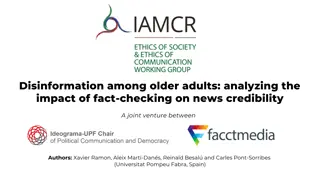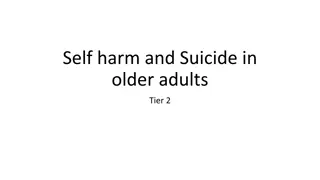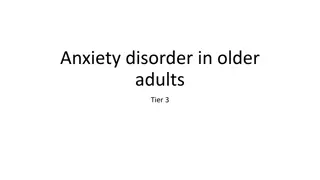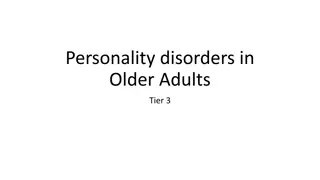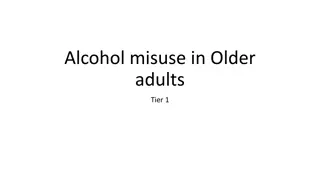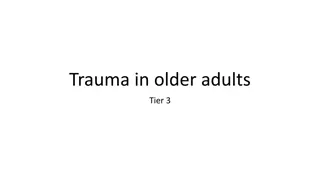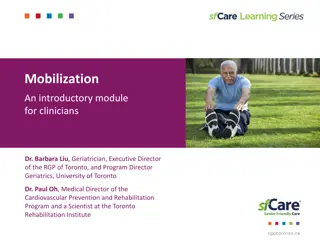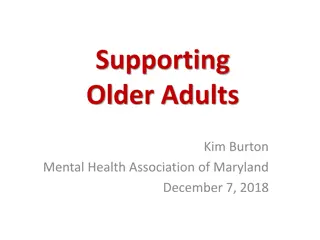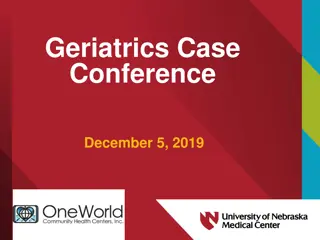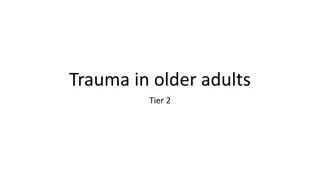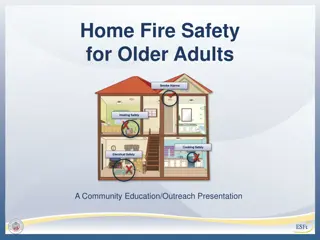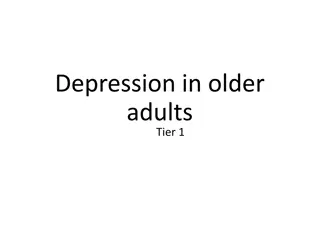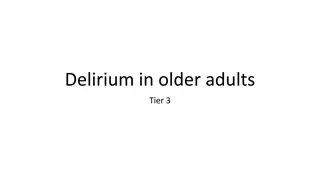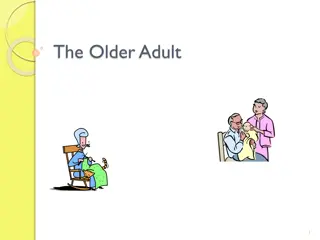Understanding Polypharmacy in Older Adults
Polypharmacy is a common concern among older adults, with approximately 40% taking 5-9 medications and 18% taking 10 or more. This module discusses the factors contributing to polypharmacy, consequences of problematic polypharmacy, strategies for detection and intervention, and the difference between appropriate and problematic polypharmacy. It emphasizes a senior-friendly approach to medication management to optimize benefits and reduce risks for older adults.
Download Presentation

Please find below an Image/Link to download the presentation.
The content on the website is provided AS IS for your information and personal use only. It may not be sold, licensed, or shared on other websites without obtaining consent from the author. Download presentation by click this link. If you encounter any issues during the download, it is possible that the publisher has removed the file from their server.
E N D
Presentation Transcript
Polypharmacy An introductory module for clinicians Lawrence Jackson, BScPhm, CTDP Pharmacy Clinical Coordinator, Sunnybrook Health Sciences
This module is part of the sfCare approach Patient Handout 8.5 x 11 Poster PowerPoint Presentation 2
Objectives Objectives What is 1. Identify the factors that contribute to polypharmacy polypharmacy? 2. Explain the consequences of problematic polypharmacy Impact for the older adult 3. Describe a structured approach to the detection of problematic polypharmacy Risk factors Detecting 4. Apply general strategies to limit problematic polypharmacy Addressing 5. Apply a senior friendly care approach to polypharmacy Case study Summary Senior friendly approach Questions 3
What is polypharmacy? While there is no consensus definition for polypharmacy, most studies have used a numerical threshold of 5 or more medications per day Objectives What is polypharmacy? Approximately 40% of older adults take 5-9 medications1 Impact for the older adult Risk factors Approximately 18% of older adults take 10 or more medications2 Detecting Addressing Case study Summary Senior friendly approach 1. JAMA 2017;318(17):1728 2. Duerden M, et al. Prescriber 2014;25:44-47 Questions 4
Appropriate versus problematic polypharmacy Objectives Appropriate Polypharmacy What is polypharmacy? Medication optimization ensures benefits outweigh risks Impact for the older Takes into consideration impact on outcomes important to the older adult, such as adult Risk factors Improving the duration and quality of life Detecting Symptom control Addressing Prevention It is evidence-based Case study Summary Senior friendly approach JAMA 2017;318(17):1728 Duerden M, et al. Prescriber 2014;25:44-47 Questions 5
Appropriate versus problematic polypharmacy Objectives Problematic Polypharmacy What is polypharmacy? Risk of harm exceeds the potential benefits or coexists with the benefits Impact for the older adult Risk factors Detecting Addressing Case study Summary Senior friendly approach JAMA 2017;318(17):1728 Duerden M, et al. Prescriber 2014;25:44-47 Questions 6
Impact of polypharmacy on the older adult The following risks accompany polypharmacy: Objectives What is 1. adverse drug reactions polypharmacy? 2. drug interactions Impact for the older 3. cost adult 4. risk of non adherence Risk factors 5. risk of medication errors Detecting 6. Precipitate or exacerbate geriatric syndromes Addressing Case study Summary Senior friendly approach Questions 7
Impact of polypharmacy on the older adult Geriatric syndromes Objectives Falls What is Functional impairment polypharmacy? Cognitive impairment Impact for the older adult Urinary incontinence Risk factors Impaired nutrition Detecting Dehydration Constipation Addressing Case study Summary Senior friendly approach Questions 8
Risk factors for polypharmacy Objectives Multiple medical problems/ multiple medications What is polypharmacy? Increased risk of problematic polypharmacy Impact for the older adult + Reduced homeostatic mechanisms and organ dysfunction Risk factors = Detecting OR Addressing + harmful medication effects Case study Acute illness or change to medications AND/ OR Summary Frailty Senior friendly approach Questions 9
Risk factors for polypharmacy Multiple medical problems/multiple medications Objectives Treatment guideline-based prescribing What is Promotes multiple medications polypharmacy? Conditions for deprescribing uncertain ADRs and prescribing cascade Impact for the older adult An adverse reaction to one drug may go unrecognized/ misinterpreted Risk factors Detecting Healthcare provider inappropriately prescribes a second drug to treat signs/symptoms Infrequent medication review Addressing Case study There is a lack of incentive to deprescribe Summary Unnecessary drugs or doses not adjusted Senior friendly approach Questions 10
Risk factors for polypharmacy Reduced Homeostatic Mechanisms & Organ Dysfunction Objectives A decline in physiologic reserves associated with aging causes the older adult to become less resilient to various causes of stress such as acute illness or injury, or the effects that medications have on the body. The combination of increased stressors and a decrease in physiologic reserve can lead to adverse outcomes such as hospitalization or death. What is polypharmacy? Impact for the older adult Risk factors Detecting Addressing Case study Summary Senior friendly approach Taffet GE, Physiology of aging. In: Cassel CK, Leipzig RM, Cohen HJ, et al [eds]. Geriatric Medicine: An Evidence-Based Approach, 4th ed. New York, Springer, 2003 Questions 11
Risk factors for polypharmacy Reduced homeostatic mechanisms and organ dysfunction Objectives What is Pharmacokinetics changes Pharmacodynamics changes polypharmacy? Impact for the older adult Changes in physiology with aging: Changes in how the body acts on the drug Changes in how the drug acts on the body Risk factors Detecting Absorption Distribution Metabolism (liver) Excretion (kidney) body fat body water albumin liver metabolism renal function Changes in receptor binding # of receptors and receptor activity Drug efficacy Toxicity / ADRs Addressing Case study Summary Senior friendly approach Questions 12
Risk factors for polypharmacy Frailty Objectives Older people are vulnerable to medication- related problems associated with frailty. What is polypharmacy? Characteristics of frailty Unintended weight loss due to inadequate nutrition Slow walking speed Impaired grip strength Exhaustion Self reported decline in activity levels Impact for the older adult Risk factors Detecting Addressing Case study Summary Robust 0 Pre-frail 1-2 Frail 3 Senior friendly approach Questions 13
Risk factors for polypharmacy Frailty (cont.) Objectives Several factors are known to be associated with frailty: What is Older age Multiple medical problems (or geriatric syndromes) Taking multiple medications Multiple psychosocial problems One or more sensory impairments (vision, hearing) New onset urinary or fecal incontinence Decrease in functional status Change in mental status- cognition/affect Disruptive behavior or personality changes Frequent falls polypharmacy? Impact for the older adult Risk factors Detecting Addressing Case study Summary Senior friendly approach Questions 14
Risk factors for polypharmacy Objectives Acute illness or changes to medication can lead to problematic polypharmacy What is polypharmacy? With acute illness, usual medications can cause unanticipated harm With any change in medications or change in dose, adverse effects can result Impact for the older adult Risk factors Detecting Addressing Case study Summary Senior friendly approach Questions 15
Challenges in detecting polypharmacy Problems due to medications may occur Without any changes to the medication Objectives What is polypharmacy? Advancing age Impact for the older Coincident with acute illness or symptoms adult Risk factors ADRs masquerade as age-related changes Atypical presentation of adverse effects Detecting Side effects difficult to interpret, may go unreported Addressing Prescribing cascade Case study Summary Infrequent Medication Review There is a lack of incentive to deprescribe Senior friendly approach Questions 16
Detecting problematic polypharmacy Problematic polypharmacy can present in atypical ways, such as Objectives Exaggerated medication effects Loss of medication s effect Problems with taking medication New or worsening symptoms or conditions Decline in functional and self-care abilities Decline in mobility What is polypharmacy? Impact for the older adult Risk factors Detecting Addressing Case study Confusion and falls are important clues that resilience is compromised in an older adult and should prompt a search for causes, including medications! Summary Senior friendly approach Questions 17
Addressing polypharmacy Assess medication list with an available tool Objectives What is Explicit criteria list of potentially inappropriate medications Implicit criteria or comprehensive assessment Medication assessment framework polypharmacy? Impact for the older adult Risk factors Detecting Addressing Case study Summary Senior friendly approach Questions 18
Addressing polypharmacy Explicit criteria lists of potentially inappropriate medications (PIM), for example Objectives STOPP/START What is polypharmacy? Suggests drugs to avoid and drugs to use Impact for the older Beers Criteria List adult Suggests drugs to avoid and highlights high alert medications / patients Risk factors High alert medications anticholinergic activity Benzodiazepines Tricyclic antidepressants Warfarin NSAIDs Fluoxetine Digoxin Oxybutynin High alert patients Impaired renal function Impaired cognition or senses Falls Hypotension Diabetes Parkinson s disease Poor nutrition Detecting Addressing Case study Summary Senior friendly approach Questions Age and Aging 2015; 44(2):2013-218 J Am Geriatr Soc 2019;67(4):674-694 19
Addressing polypharmacy Medication assessment frameworks Objectives DEBRIDE Tool Other Medication Assessment Frameworks What is 7-Step Review Process polypharmacy? Dose and frequency Effects Benefit Risk Indication Drug monitoring Expectations Impact for the older adult Medication Appropriate Index (MAI) No TEARS ARMOR Risk factors Detecting Addressing Case study Summary Senior friendly approach Gokula M, Homes H. Clin Geriatr Med 28 (2012) 323 341 DEBRIDE: Medication reviews in long-term care and supportive living. Alberta http://www.cpsa.ca/medication-reviews-long-term-care-supportive-living-physicians-perspective/ MAI: Hanlon JT, et al. MAI J Clin Epidemiol. 1992;45:1045 51 No TEARS: BMJ 2004;329:434 ARMOR: Haque R. Ann Long-Term Care 2009;17:26-30 Questions 20
Addressing polypharmacy Implicit criteria or comprehensive assessment Objectives Health status What is polypharmacy? Prognosis and goals of care Impact for the older Benefit risk assessment of each medication and overall combination of medications adult Risk factors Detecting Addressing Case study Summary Senior friendly approach Questions 21
Addressing polypharmacy Limiting potential harms Objectives 1. Assess risk for polypharmacy What is polypharmacy? 2. Annual review of medications in all older adults 3. Inform caregivers of medication changes to increase the chance of detecting problems as soon as possible Impact for the older adult Risk factors 4. Chose medications with the fewest side effects 5. Stop unnecessary medications Detecting 6. Consider the impact of medications on quality of life Addressing 7. Consider the person s ability to take medications and remember to take them Case study Summary Senior friendly approach Questions 22
Addressing polypharmacy A practical guide to stopping medication Objectives 3. Taper Medicine when appropriate 4. Check for Benefit or Harm after each medicine has been stopped 2. Reduce or Stop one medicine at a time 1. Recognize the Need to stop a medicine What is polypharmacy? Impact for the older adult At the first visit, halve the dose At the next scheduled visit review progress, then either: Maintain (at half dose) Continue to taper (e.g. quarter dose) Stop With the person s consent, view the discontinuation process as a trial Risk factors Time taken to taper may vary from days to weeks to months If symptoms worsen, may need to reinstate the medication Detecting Addressing Case study Summary Senior friendly approach Questions Frank C, Weir E. CMAJ 2014;186(18):1369-1376 23
Case study: Mary Mary is 85 years old and has 4 chronic conditions that require 9 medications. No changes to her medications for 5 years. One month ago a new medication was started. Soon after that, she began to feel unsteady when walking and has been incontinent of urine on 2 occasions because she is not able to get to the bathroom fast enough. One week ago, she fell but only sustained some bruising of her arm. She is mystified by these new problems and wonders if she is getting old and whether she can stay in her own apartment. She wonders if she should report these problems to her daughter. Objectives What is polypharmacy? Impact for the older adult Risk factors Detecting Addressing What s going through your mind? Case study Summary Senior friendly approach Questions 24
Is Mary at risk of problematic polypharmacy? Identify the risk factors in Mary s case Objectives What is polypharmacy? Multiple medical problems/ multiple medications Impact for the older adult + Risk factors Reduced homeostatic mechanisms and organ dysfunction Detecting Addressing Case study + Acute illness or change to medications Summary AND/ OR Frailty Senior friendly approach Questions 25
Is Mary at risk of problematic polypharmacy? Identify the risk factors in Mary s case Objectives 4 chronic conditions that require 9 medications: Prescribing cascade and increasing polypharmacy Problematic medications left unchanged Risk of further decline in health status What is Polypharmacy? Multiple medical problems/ multiple medications Impact for the Older Person + Risk Factors Reduced homeostatic mechanisms and organ dysfunction Detecting Addressing Case Study Acute illness or change to medications Summary AND/ OR Frailty Senior Friendly Approach Questions 26
Is Mary at risk of problematic polypharmacy? Identify the risk factors in Mary s case Objectives New acute condition may have: Compromised her homeostatic mechanisms; or Worsened her already impaired organ function What is polypharmacy? Multiple medical problems/ multiple medications Impact for the older adult + Risk factors Reduced homeostatic mechanisms and organ dysfunction Detecting Addressing Case study Acute illness or change to medications Summary AND/ OR Frailty Senior friendly approach Questions 27
Is Mary at risk of problematic polypharmacy? Identify the risk factors in Mary s case New health problems not attributed to medications: Urinary incontinence, via decreased mobility Fall Confusion: Mary is unsure if episodes should be reported to daughter Psychological distress: Mary is worried about ability to live independently Objectives What is polypharmacy? Multiple medical problems/ multiple medications Impact for the older adult + Risk factors Reduced homeostatic mechanisms and organ dysfunction Detecting Addressing Case study Acute illness or change to medications Summary AND/ OR Frailty Senior friendly approach Questions 28
Is Mary at risk of problematic polypharmacy? Recently been prescribed a new medication for a new condition/acute illness Usual medications have caused unanticipated harm Recent medications were not communicated to Mary s daughter, leading to insufficient health monitoring and reporting No recent medication review Identify the risk factors in Mary s case Objectives What is polypharmacy? Multiple medical problems/ multiple medications Impact for the older adult + Risk factors Reduced homeostatic mechanisms and organ dysfunction Detecting Addressing Case study Acute illness or change to medications Summary AND/ OR Frailty Senior friendly approach Questions 29
Case study: Mary - resolution Finally, apply the Medication Review Framework (DEBRIDE) to determine if Mary can benefit from de- prescribing. Objectives What is polypharmacy? Dose and frequency - Is the dose and frequency correct based on age and organ function? Effects - Have the known side effects been considered? Benefit - Will Mary benefit from treatment given goals of care? Risk - Is the medication considered a high risk medication? Indication - Is the indication for the new medication clear and valid? Drug monitoring - Is a monitoring plan in place to assess benefit and harm? Expectations - Are the expectations of benefit to be achieved realistic? Impact for the older adult Risk factors Detecting Addressing Case study Summary Senior friendly approach Questions 30
Summary Polypharmacy is common 65 years due to multiple conditions requiring medications polypharmacy can be appropriate or problematic Objectives What is polypharmacy? Risk of harm increases with # medications, frailty, and illness inconvenience hospitalization ..death Impact for the older adult Risk factors Medication appropriateness may change over time decline in functional reserves of organs (frailty) maintenance medications may become harmful medication changes result in adverse effects or new drug- interactions Detecting Addressing Case study Summary Medication appropriateness may change with acute illness loss of physiologic reserve causes medications to have an enhanced effect Senior friendly approach Questions 31
Summary Recognizing problematic polypharmacy is difficult Objectives medication problems can occur without a change in medications tools are available to structure the medication assessment process each patient is unique, medication decisions require clinical judgement all care providers can contribute to medication problem identification and reporting What is polypharmacy? Impact for the older adult Risk factors Detecting Addressing Case study Benefit/harm ratio can change in an instant or gradually over time. Regular medication review provides an opportunity to detect problems, adjust doses based on changing physiology and consider medication deprescribing. Summary Senior friendly approach Questions 32
Summary Strategies to limit the potential harms due to polypharmacy Objectives What is polypharmacy? 1. Assess polypharmacy risk Impact for the older 2. Annual review of medications in all older adults adult 3. Inform caregivers of medication changes to increase the chance of detecting problems as soon as possible Risk factors Detecting 4. Chose medications with the fewest side effects 5. Stop unnecessary medications Addressing 6. Consider the impact of medications on quality of life Case study 7. Consider the person s ability to take medications and remember to take them Summary Senior friendly approach Questions 33
The senior friendly approach How all healthcare providers can address polypharmacy using a senior friendly care approach Objectives Leadership-supported medication reviews Providing staff and patient education What is polypharmacy? Organizational Organizational Support Support Impact for the older adult Changes in condition prompt a medication review regardless of patient age Emotional & Risk factors Emotional & Behavioural Environment Behavioural Environment Detecting Processes of Care of Care Processes Addressing Medications are meeting the older adult s goals Ethics in Clinical Ethics in Clinical Care and Research Care and Research Case study Summary Facilitate medication reviews Medication reminder systems to increase adherence Physical Senior friendly approach Physical Environment Environment Questions 34
Discussion questions Objectives What is Which of the strategies to limit the potential harms due to polypharmacy (slide 33) are you already using in your practice? What are some of the barriers to implementing strategies to limit the potential harms due to polypharmacy (slide 33)? What is one strategy that you can implement moving forward? polypharmacy? Impact for the older adult Risk factors Detecting Addressing Case study Summary Senior friendly approach Questions 35
The sfCare Learning Series received support from the Regional Geriatric Programs of Ontario, through funding provided by the Ministry of Health and Long-Term Care. V1 July 2019



